Tag: Bodybuilding
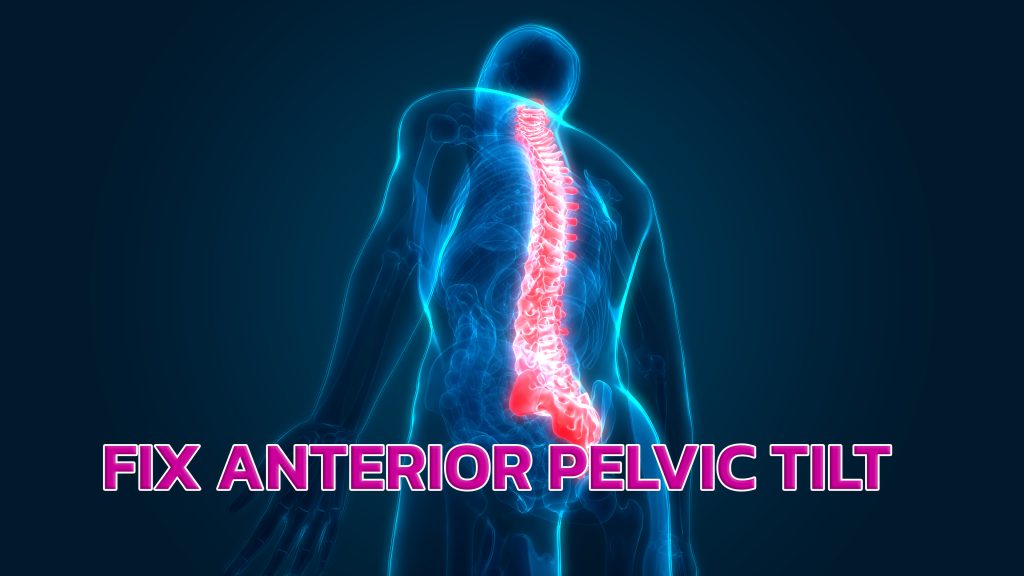
Anterior Pelvic Tilt Fix for Bodybuilders
There have been many instances of pelvic tilt among people with poor sitting positions or those who sit for many hours. Research has shown that most people with this problem are either office workers or people who spend hours playing computer games, but it also affects bodybuilders. The condition manifests itself in later stages when it starts affecting several aspects of a person’s life, but is barely noticeable when it starts setting in. The anterior pelvic tilt colloquially referred to as APT, is characterized by an inward curving of the pelvic bone. The person may also show signs of a protruding abdomen. Anterior pelvic is related to two other pelvic conditions-posterior pelvic tilt and lateral pelvic tilt. Although not very common, these two other pelvic tilts affect the way a person walks, kicks, or runs.
Scientifically, anterior pelvic tilt occurs when there is a slight dislocation or shortening of the pelvis such that the front and back regions of the pelvis are not aligned. That means the person’s walking or running will be affected. Additionally, the person may develop weak abdominal muscles and glutes if the condition is not fixed in its early stages. Some people with a pelvic tilt have also reported pain in the lower back, knees, and legs. The anterior pelvic tilt is also linked to involuntary hip and knee movement. That is not to mention the obvious sign- improper posture.
Anterior Pelvic Tilt Test
How does one whether they have an anterior pelvic tilt or not? Well, you may not notice it through posture until sometime later. However, several scientific tests have been proposed, one of them being the Thomas Test. Here is how to conduct the test:
Lie on your back, on a sturdy stable, with your legs hanging off the table.
Raise your left leg and put it on the table, hold it still with your hand.
Pull the leg towards your chest slowly until it touches it.
Check if the back of the other leg is resting on the table.
Repeat the procedure with the other leg.
If you have a pelvic tilt, the back of the leg hanging off the stable will be slightly lift off it. You will notice that you have to shift to keep it from lifting off the stable. A person with a normal pelvic will not have trouble keeping the leg rested until you release the other.
Anterior Pelvic Tilt Fixes
There are several ways you can fix a pelvic tilt without necessarily undergoing surgery. Most of these fixes are done with physical exercises. However, you need to be careful with the type/intensity of the exercise if you have back pain. You don’t want to make the pain worse by doing strenuous exercises which you think will give quick results. Strengthening the muscles will not always fix a pelvic tilt, strengthening the posterior pelvic tilt does. There are a couple of ways you can use to achieve this.
Must Read:: Training Template by Lift Run Bang
1. Press Your Back Against the Ground
The first step in fixing a pelvic tilt is practicing to press your back against the ground. People with a severe tilt will not find this easy, so it will take a lot of exercises to finally push your back against the ground. To achieve this easily, you need to lie your back on a sturdy surface that is soft enough for you. Now fold your legs at the knee and straighten your hands on the sides. Remain in that position for as long as you can.
2. Contract your Glutes While Standing
Squeezing your glutes will make your posture appear a bit more natural from some angles. Stand with your feet together and keep your hands relaxed at the sides. Now push your hips down and back as you stretch your hands in front of you. Go as low as you can and only stop when your back starts to hurt. Take a rest for 30 seconds and repeat the procedure. You can do five to 10 rounds every day to master it fully.
3. Avoid Sleeping on Your Stomach
It has been found that sleeping on your stomach will likely extend your front pelvis. It is even worse if you support your head with your hands or pillow. But sleeping on your back does not only make you comfortable but will also ensure you don’t develop a pelvic tilt. You may feel comfortable sleeping with your stomach you must not make it a habit. If you have to, then don’t do so for long hours. Start sleeping on your side and transition to your back and you will master it with time.
Must Read:: The Importance of Sleep for Bodybuilders
4. Perform More Hamstring Exercises
These exercises are meant to stretch muscles found in your lower back. The exercises may not necessarily make APT go away but they’ll ensure you have a painless back, even with the condition. Additionally, hamstring exercises ensure your muscles don’t lose their flexibility when you assume the same posture for long. Here is how to perform a simple hamstring exercise:
Look for a standard-height table.
Sit on it and straighten your back.
Stretch one leg forward and support it at the back of the knee with your hand. Hold in that apposition for 30 seconds.
Repeat with the other leg.
Do 10 to 15 sets every day.
5. Half-Kneeling Stretches.
Half-kneeling stretches will not only increase the flexibility of your hip joints but will also strengthen lower back muscles. Additionally, the stretches are ideal for people with anterior pelvic tilt because you allow your back to move according to the knee’s movement. Here is how to perform a simple half-knee stretch:
Go down on your knees.
Straighten your back.
Lunge with one leg as the other rests on the floor.
Tighten your abdominal muscles as you squeeze your glutes.
Move your pelvis forward until you feel the stress.
Rest for 30 seconds and repeat with the other leg lunged.
Do 10 to 15 sets of the exercise every day.
6. Roll the Foam
Foam rolling is one of the most popular exercises in our gyms. Little do most people know it can be used to fix several physical conditions. Rolling the form on your entire back will not only relax the back muscles but can also fix anterior pelvic tilt. To perform the exercise, find foam and lie on your back, your hands hanging freely, and your feet on the flow. Slowly roll the foam from the middle–back to the lower back for as long as you’re comfortable.
7. Rear Leg Raise Exercises
Weak heap and abdominal muscles are some of the symptoms of anterior pelvic tilt. Rear leg raise exercises help tighten these groups of muscles, thus helping you improve your stability. The exercises may be a little strenuous but you don’t have to do them intensely. Follow this procedure to perform them.
Start by getting to all fours on an exercise mat or carpet.
Take a deep breath and exhale, squeezing your stomach muscles in the process.
Take the back of your right knee with the right hand, then tilt towards the left.
Slowly pull the leg forward until you feel the tension.
Repeat with the left leg.
As you perform the exercises, make sure to remain in the position for 20 seconds. Also, take 30 second rests between rounds to avoid getting fatigued quickly. You can do 5 sets of these exercises every day.
8. Simple Squats
Squats are a great way of exercising but they can also help with APT. There is nothing much to explain about squats because almost everyone has done it at some point. But people with this condition could not be in a position to do them right, so we will explain.
Stand upright with your legs slightly apart.
Stretch your hands forward, perpendicular to your body.
Slowly push your hips back and down until feeling the tension.
Remain in that position for 15 seconds.
Rest for 10 seconds and go again.
Make sure you do the squats frequently to realize results. Most importantly, only do rounds you can manage to avoid putting a strain on your lower back.
9. Hip Muscle Flexing Stretches
These exercises are meant to strengthen the hip muscles but can also help with lower back pain. However, you have to be careful not to put too much strain on that region because it could weaken it further. The exercises are simple but you need to do them consistently however easy they may seem.
Stand upright and stretch your hands outwards.
Put your right leg forward and make sure the knee makes a right angle.
Move your body forward towards the knelt knee and tighten stomach muscles.
Keep moving until you feel the tension.
Remain in that position for 15 seconds.
Change to the left leg and repeat the procedure.
Do 10 to 15 sets.
Related Article:: Get Rid of Stretch Marks During the Steroid Cycle or Post Steroid Cycle?
When to See a Doctor?
Anterior pelvic tilt can interfere with many aspects of your life if it goes unchecked for long. For instance, the condition could rob you of your favorite sport. Additionally, most people who develop a pelvic tilt at later stages of their lives tend to lose their confidence. If the condition happens to reach that far, then it about time you booked an appointment with a doctor. The doctor may not necessarily recommend surgery but they will help you choose exercises that are most appropriate for your condition. That will help you avoid extreme exercises that will do more harm than good to you.
Overall
It is important to know that anterior pelvic tilt is not a disability but a severe case that may affect a person’s life significantly. Luckily, the exercises discussed above can help you manage its more severe symptoms such as the back, knee, and hip pain. The exercises will also prevent the weakening of the stomach and hip muscles which are caused by APT.
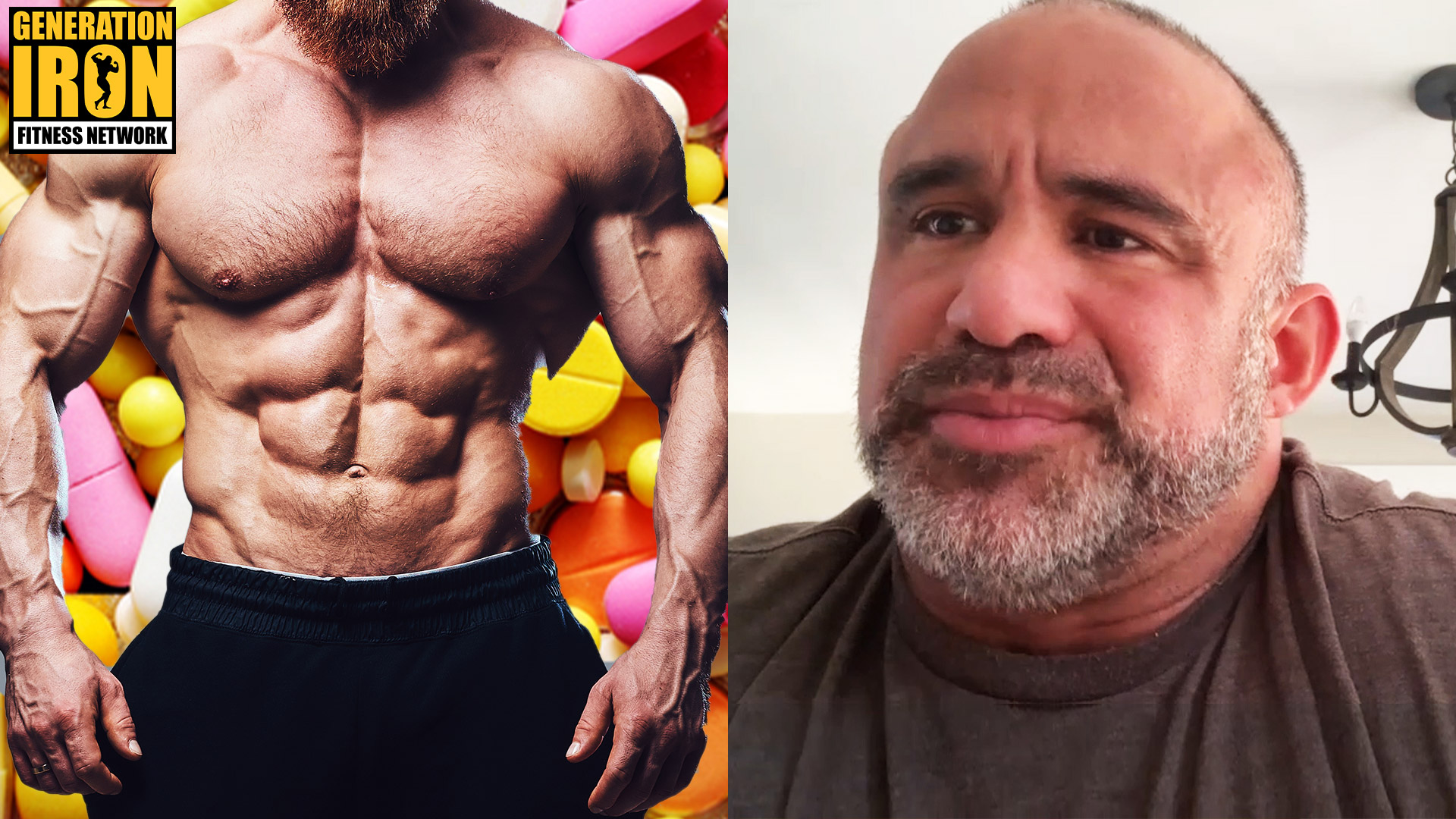
Jose Raymond’s Warning: Avoid Coaches Who Rely Too Strongly On Drugs
Jose Raymond shares the biggest red flags when choosing a bodybuilding coach.
Jose Raymond has been a competitive bodybuilder since 1993. While he had to step down for a few years due to an injury, he has been actively involved with bodybuilding for nearly 3 decades. So it stands to reason that his advice on what to look for in bodybuilding coaches should be taken seriously. In our latest GI Exclusive, Jose Raymond warns of the biggest red flags to look for when choosing a bodybuilding coach.
Jose Raymond didn’t start working with a bodybuilding coach or guru until he was 37 years old. That’s because he wanted to exhaust every single one of his own resources to see how far he could climb before turning to expert help. That kind of mentality showcases how rigorous and serious Raymond took his own role in bodybuilding. It’s his first tip for young bodybuilders today looking for advice on finding a bodybuilding coach.
Far too often, a bodybuilding coach is seen as a necessary key to success in pro bodybuilding. While a coach can be extremely helpful, they are not a catch-all tool to instantly make a bodybuilder better. At the end of the day, the bodybuilder does the work and follows the plan. So before turning towards a coach, Raymond suggests that a bodybuilder does the work to ensure they have exhausted all personal resources. This way – the bodybuilder will know they are ready to put everything in to working with a coach and succeeding.
Of course, when starting the journey of looking for a coach, the biggest question is who do you trust? There are certainly famous names in bodybuilding with proven pedigrees. But not all bodybuilders will have the luck or opportunity to work with them. In today’s internet landscape, it can be hard to tell the tried and true coaches from the hacks looking to make easy money.
[embedded content]
Check out our GI Exclusive segment with Jose Raymond above!
That’s why Jose Raymond shares some red flags that bodybuilders should look out for when choosing a coach. These are key factors that should give the bodybuilder an immediate warning to stay away and find someone else.
His first tip is to look for a coach that still embraces the basics. While it’s certainly okay for a coach to bring in some groundbreaking material into their practices – they should also respect the basics that work. Science does evolve and opinions on fitness do change but certain fundamentals will always be true. If you find yourself with a coach who is trying to reinvent the wheel and throw away tried and true basics – that should be a warning sign.
Secondly, Jose Raymond believes that a coach who focuses too much on drugs is a red flag. Raymond admits that drugs are always going to be a part of any professional sport. It will be an element for top tier pro athletes. But Jose Raymond believes that more recently, the importance of drugs has become overstated. Many bodybuilders go into a coaching relationship only looking for a drug protocol. That is not the main thing a coach should be doing.
So Jose Raymond’s advice is to turn away from any coach that claims he can provide a drug protocol that will make you successful. More is not always better when it comes to drugs. Moreover, drugs are not the most important element in bodybuilding. Any coach who tells you that is not the right coach.
So ultimately there are two key takeaways Jose Raymond hopes to convey for up and coming bodybuilders. Don’t look for coaches that throw away the basics. And don’t look for coaches that act more like drug dealers than trained professionals. If you avoid those two things, do your research, and find a credited trainer – you’ll find yourself getting the help you need for success.
You can watch Jose Raymond break down his advice for bodybuilding coaches in full by watching our latest GI Exclusive interview segment above!
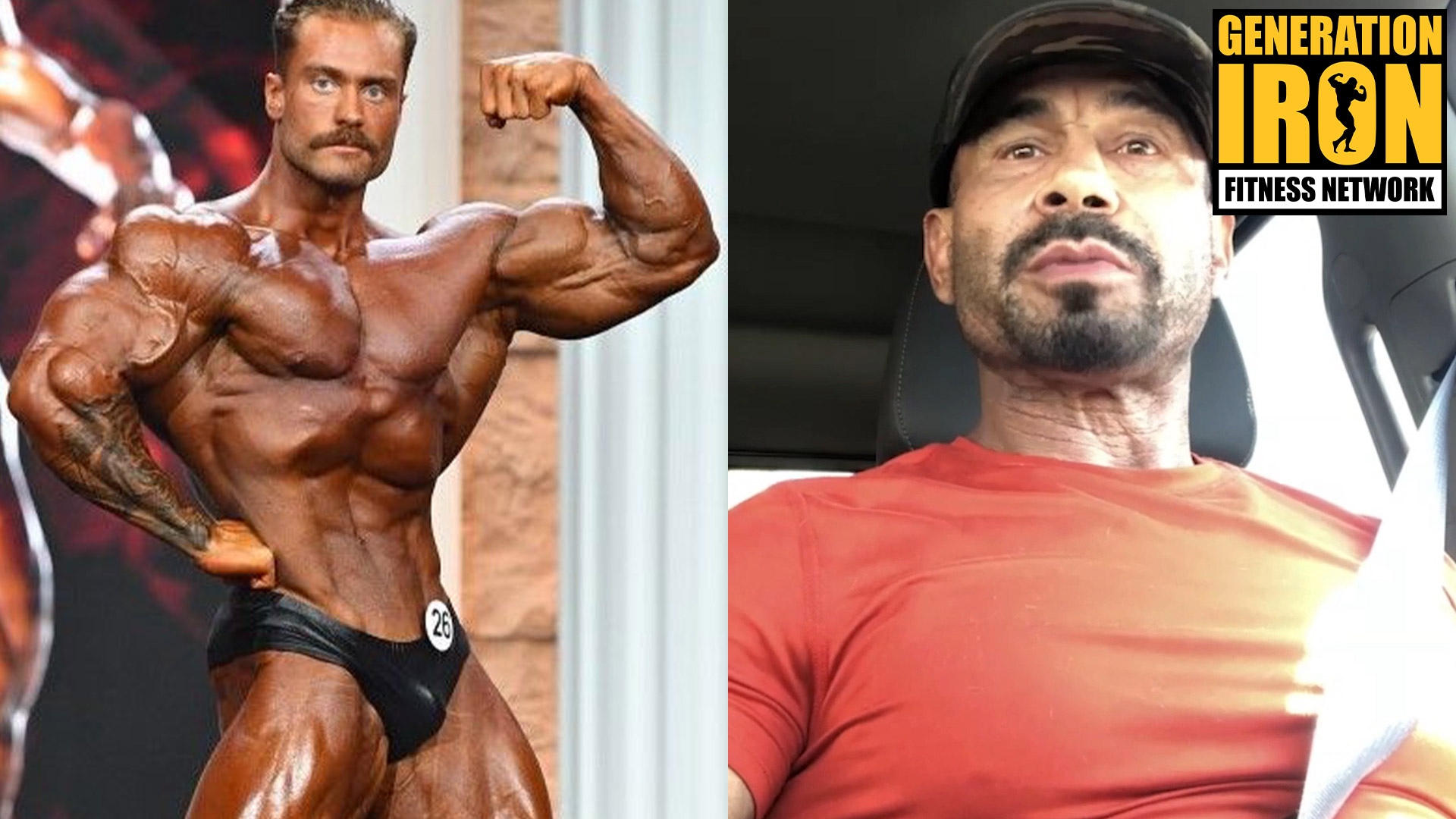
Danny Hester: Chris Bumstead Won Olympia Due To Improvements But Not Perfection
Danny Hester believes that Chris Bumstead’s physique was very close to Breon Ansley – but it was his massive improvements that earned him the win.
Chris Bumstead vs Breon Ansley was one of the most hyped up battles of the Classic Physique Olympia 2020. Ultimately, Chris Bumstead solidified his status as champion with a second win. Surprisingly, Breon Ansley fell down to third place. But Danny Hester believes that Bumstead and Ansley’s physiques were actually very close in quality. What made the difference was Bumstead’s massive improvements since last year.
The same can be said of Terrence Ruffin, who slipped up into second ahead of Breon Ansley. These three competitors were neck and neck. It’s Danny Hester’s belief that comparisons to previous years and how much they each improved decided the ultimate placings. In our latest GI Exclusive interview, Danny Hester explains how judges consistently reward improvements – and that’s the main reason Chris Bumstead won Olympia 2020.
Danny Hester wants to make one thing clear during our latest interview segment. When a bodybuilder competes on stage, they are being not only compared to the other competitors but also their past self. Pro bodybuilding and judges cannot help but be somewhat subjective. Despite scores and a set of guidelines to follow – judging a physique will always be skewed by subjective opinion.
That’s why there are multiple judges on the panel instead of just one. To help bring in a consensus among multiple perspectives. Danny Hester also believes that comparisons to previous competitions also helps keep the judges guided. That it’s an unwritten guiding principle with scoring. If a bodybuilder shows incredible improvement from one competition to the next – the judges take notice. That affects the overall score and placing.
[embedded content]
Watch our GI Exclusive segment with Danny Hester above!
Danny Hester doesn’t give his personal opinion on who had the best physique at the Classic Physique Olympia 2020. But he does suggest that the physique quality was very close between Chris Bumstead and Breon Ansley.
“Now even with the improvements, was it enough for him [Chris Bumstead] to beat Breon? That’s a whole different story,” Danny Hester states in our interview. While not confirmed -this seems to imply that Hester doesn’t view Bumstead’s physique as breakaway superior from Ansley.
He does understand, and truly believes, that Chris Bumstead won purely on his vast improvements. Hester himself gives Bumstead credit. He admits that the amount of improvements in Bumstead’s physique from the Olympia 2019 to 2020 was incredible. It’s hard for any pro bodybuilder to get that kind of improvement in one year. Bumstead pulled it off. The judges noticed. That gave Bumstead the edge.
Danny Hester relates this to his experience competing. He recalls a competition he competed in just three weeks before winning the Classic Olympia. He placed third due to feeling slightly sick on the night of the show. He was frustrated. So he worked extra hard in the final three weeks leading up to Olympia.
Ultimately, he won the Classic Physique Olympia. He thinks this is partially due to the extra effort he put in after feeling defeated. But he also thinks it’s because some of the same judges were at the earlier show and also judging at Olympia. They saw his improvements. They directly noticed how he changed. That helped him get an edge and win that year.
So what does that mean for Chris Bumstead going into 2021? There are always improvements to be made – but can he surprise with such vast improvements like the year before? And if he can’t will it be enough for him to stay on top? Only time will tell. Perhaps Breon Ansley will be the one to bring in improvements and get the edge.
You can watch Danny Hester go into more detail about his thoughts of the Classic Physique Olympia results by watching our latest GI Exclusive above!
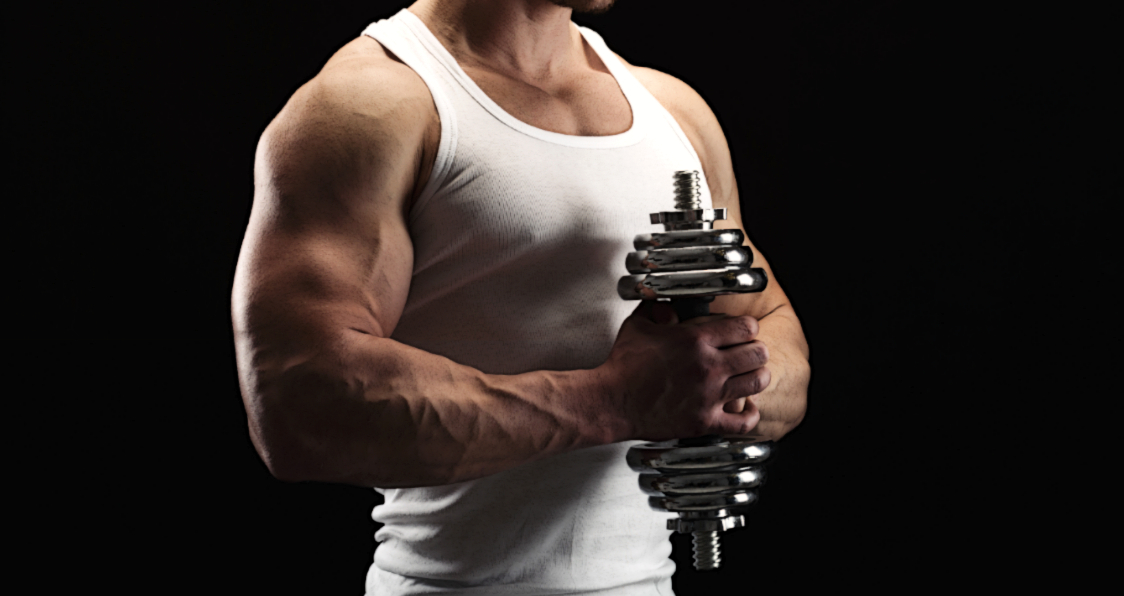
7 Ultimate Training Tips For Developing Forearm Size
Building The Forearms for Fuller Looking Arms
When looking to build significant muscle size, training tends to focus on developing large muscles groups such as the glutes, quads, lats, pecs and delts.
While the arms do often receive a lot of attention too, the focus is predominantly on the muscles of the upper arm – the biceps and triceps.
As a result, the forearms can be neglected and therefore can under-develop in comparison to other areas.
It is important to build size and definition in the forearms in order to develop full-looking arms that matches your overall physique.
The general approach to forearm building is to concentrate on forearm isolation exercises for the forearm flexors and extensors – exercises such as wrist curls.
While these types of exercises can certainly allow for forearm growth, there are a number of other methods that can be employed to accelerate the rate of development.
The 7 Tips For Big Forearms
If you are serious about building size in the forearms, adopt a number of the following 7 tips and look to incorporate them into your training program.
1) Ditch the Straps
Wrist straps can be an excellent training tool which eliminate the detrimental impact of failing grip strength by securing the bar to the hands (1).
With exercise like the deadlift, failing grip strength can cause the individual to cease exercising before they reach absolute muscular failure.
Adding wrist straps will provide a much securing grip on the bar and allow the performer to work through to muscular failure without the grip slackening and failing.
However, when it comes to building size in the forearms, leave the straps in the locker room.
During all pulling exercises, you hold the bar by wrapping the fingers and thumbs tightly around the equipment your using, otherwise it will fall out of your grasp.
The extrinsic muscles of the forearms must work hard to maintain a secure grip throughout the duration of the exercise (2). Over time, these muscles will improve in strength and increase in size.
Furthermore, the heavier the load lifted, the more the forearms flexors must engage. Therefore, when lifting heavy, forget using straps in order to get maximize forearm activation.
There are a number of common pulling exercises that are excellent for forearm development and grip strength – exercises such as the deadlift, barbell row, and chin-ups.
Pushing exercises, such as the bench press and overhead press, are also effective forearm extensor developers – however, pulling exercises are superior for forearm engagement.
2) Grip Hard
Leading on from the last tip, it may be the case that you want to work the forearms but do not want to forgo using wrist straps.
This is absolutely fine. It is still possible to work the forearms effectively while still using the straps.
Here are two methods that are particularly useful for really pumping up the forearms.
Grab a barbell, place it on a power rack and load it up. Grip tightly and look to hold it at arms length for approximately 30 – 60 seconds.
It is also possible to this with dumbbells too. Select two heavy dumbbells, secure your grip and hold, again for 30 – 60 seconds.
Look to repeat this 8-10 times to really get the forearms burning.
3) Utilize Cables
As mentioned earlier, one of the most common forearm exercises is the wrist curl and reverse wrist curl. Barbells and dumbbells are most frequently used with this exercise.
However, the cables may be a better choice when it comes to wrist curls. This is because the cables maintain tension throughout the entirety of the movement.
This places an even greater demand on the wrist flexors and extensors and which may lead to a more efficient development of the forearms.
For the cable wrist curl, attach a short bar to the cable and adjust the pulley to the lowest position. Using D rings for this exercise is also acceptable.
In a kneeling position, place the forearms on the knees and use the thighs like a preacher bench. If preferred, set up a preacher bench in front of the cable machine instead.
Focus on flexing and extending the wrist only and perform the prescribed number of reps. It may be of greater benefit to focus on one wrist at a time rather than both simultaneously.
4) Go Old-School
You don’t need the latest fitness equipment to work the forearms effectively. In fact, there are a number of excellent forearm exercises that use basic kit.
One of the simplest exercises uses a dowel and a length of string. Insert the string through dowel, attach a weight to the string and the look to turn the dowel round and round to bring the weight up.
Once the weight has risen up to the dowel, unravel the string by gradually turning the dowel back and lowering the weight to the floor once again.
The hand gripper is another example of another basic piece of forearm developing kit. You can buy hand grippers with a range of grades.
Some take 60 pounds of pressure to close whereas others can be as high as 360 pounds of pressure! Be aware, this exercise is a lot more challenging than it looks.
5) Increase Wrist Training Frequency
The forearms are made up of dense muscle tissue which can be a little more resistant to change. Therefore, training them more often is crucial to facilitate size improvements.
Furthermore, research indicates that one of the most effective methods of promoting muscular hypertrophy is to increase the frequency of training (3).
Therefore, if looking to accelerate forearm hypertrophy, consider performing forearm orientated exercises more regularly – perhaps as much as every second day.
Be careful not to schedule forearms into your training the day before performing back and biceps. Having sore forearms when performing pulling exercises may negatively impact your performance.
6) Use a High Rep Scheme
Typically, for hypertrophy, a rep range of 6-12 reps will suffice. However, for forearm training, it is recommended to aim a lot higher than that.
Aim to complete high rep sets with a minimum of 15 reps. Feel free to experiment with rep ranges utilizing anything between 15 – 50 reps per set.
Many individuals believe that completing high reps does not positively impact the rate of muscle growth. However, high reps have been found to be beneficial when it comes to hypertrophy (4).
7) Consider Loaded Carries
Finally, it may be worthwhile adding in heavy carry exercises into your training – exercises such as the dumbbell farmers walk.
Not only will these type of exercises place a great demand on your grip strength and forearms, they are also very simple to set-up and execute.
For the dumbbell farmers walk, all that is required is a clear space and a heavy load. Simply pick up the load and take a number of steps forward while keeping the weight tight to the body.
Keeping going until the grip gives in and forces you to stop. Over time, gradually add more load to continuously challenge the forearms and force them to adapt.
Final Word
While wrist isolation exercises are very useful for developing forearm size and strength, there are a number of other strategies that can be adopted to bring about substantial growth.
Consider utilizing a number of the aforementioned forearm tips to your training, train hard, be consistent and over time, the forearms will noticeably grow causing the arms to look comprehensively bigger and fuller.
For more news and updates, follow Generation Iron on Facebook, Twitter, and Instagram.
References:
1-Coswig, Victor S.; Machado Freitas, Diogo Felipe; Gentil, Paulo; Fukuda, David H.; Del Vecchio, Fabrício Boscolo (2015-12). “Kinematics and Kinetics of Multiple Sets Using Lifting Straps During Deadlift Training”. Journal of Strength and Conditioning Research. 29 (12): 3399–3404. doi:10.1519/JSC.0000000000000986. ISSN 1533-4287. PMID 26595133
2-Mitchell, Brittney; Whited, Lacey (2019), “Anatomy, Shoulder and Upper Limb, Forearm Muscles”, StatPearls, StatPearls Publishing, PMID 30725660
3-Ochi, Eisuke; Maruo, Masataka; Tsuchiya, Yosuke; Ishii, Naokata; Miura, Koji; Sasaki, Kazushige (July 2, 2018). “Higher Training Frequency Is Important for Gaining Muscular Strength Under Volume-Matched Training”. Frontiers in Physiology. 9. doi:10.3389/fphys.2018.00744. ISSN 1664-042X. PMC 6036131. PMID 30013480.
4-pubmeddev. “Effects of Low- vs. High-Load Resistance Training on Muscle Strength and Hypertrophy in Well-Trained Men. – PubMed – NCBI”. www.ncbi.nlm.nih.gov.
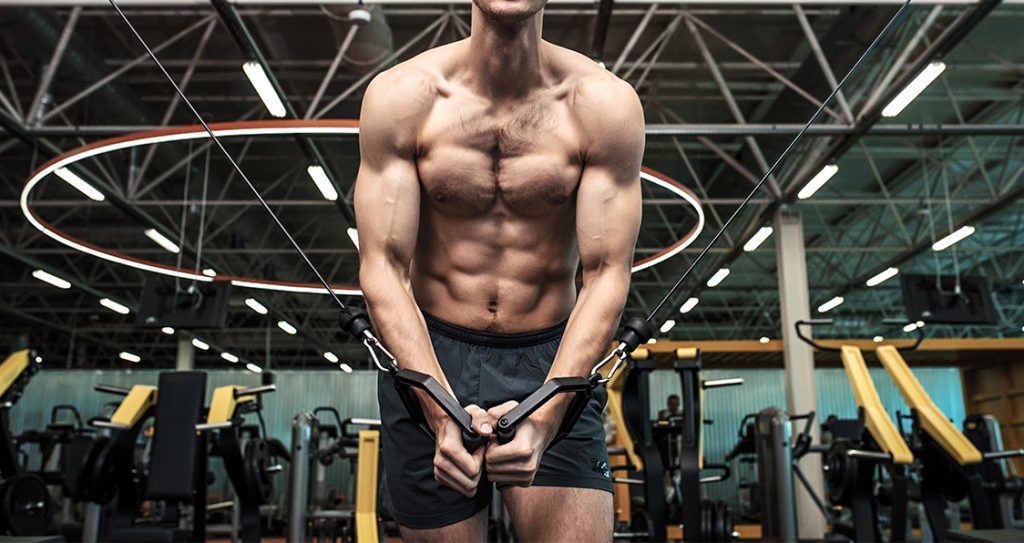
4 Reasons Why You’re Getting Weak
Past the point of diminishing returns
We Know you guys go hard. Lifting day in and day out, monitoring your macros, taking your supps, and pushing yourself to the limit in the gym. However, there’s a point of diminishing returns. If you’re doing “everything right” but find yourself getting weaker or stuck on a plateau, something’s up. While there are a myriad of reasons things could be going south with your gains, here are some of the most common mistakes that may be giving you less than ideal results.
Your workout schedule is too strict
Yep, you guessed it. One of the number one reasons you’re not getting enough mass is because you’re probably “doing the most”. Chill, you’re on your way to a mental and physical breakdown. If you find you’re not reaching your goals as fast as you’d like try taking a week off *gasp, the room goes silent*. Seriously though, you can still stay active and fit just take a sabbatical from the weight room. It’s okay, we won’t tell anyone.
The order of your exercises are wrong, wrong, wrong.
Going to failure with chest fly’s and dips is an almost sure fire way to decrease your chest press performance later on in your routine. The order of your exercises greatly predict how much strength and energy you’ll have left for secondary movements. Try putting the most important or large muscle group exercises (bench press. deadlift, squat, etc.) first and leave the accessory movements for later. That way your body will be ready to push out some huge numbers.
Your form is tore up from the floor up
When know you want to add weights. You want to post your squat numbers on facebook, instagram, snapchat, and every form of social media there is. Unfortunately for your gainz, that’s not going to work. Just like a leaky basement, if you’re foundation is wrong you’re all sorts of messed up. You can get away with this at lighter weights, but once you start to get with the big boys, your cracks will start to show. Take some weight off the bar and practice perfect form. Also, focus on a mind-muscle connection that lets you truly feel which parts of your body is most affected by a particular exercise. This will automatically have you thinking about the way your shoulders are positioned for a bench press or engaging your lats during a deadlift.
Your recovery plan is flawed
What’s that? A recovery plan involves more than just a shake? Sadly, yes. If you’re going to break down those rock formations you refer to as muscles and expect to comeback with the strength (and size) of hercules you’re going to need some rest. But this doesn’t necessarily mean sit and the couch and watch football rest. You can do things like foam rolling, stretching, and light cardio to encourage blood flow and loosen up tight muscles.
There you have it. 4 arch nemesis’s of hard earned gainz. Try making these 4 tweaks to your already stellar workout and watch your strength and size increase in proportion to the work you’re putting in.
Hit us up in the comments section below. What other problems do you feel everyday bodybuilders face in reaching their goals?
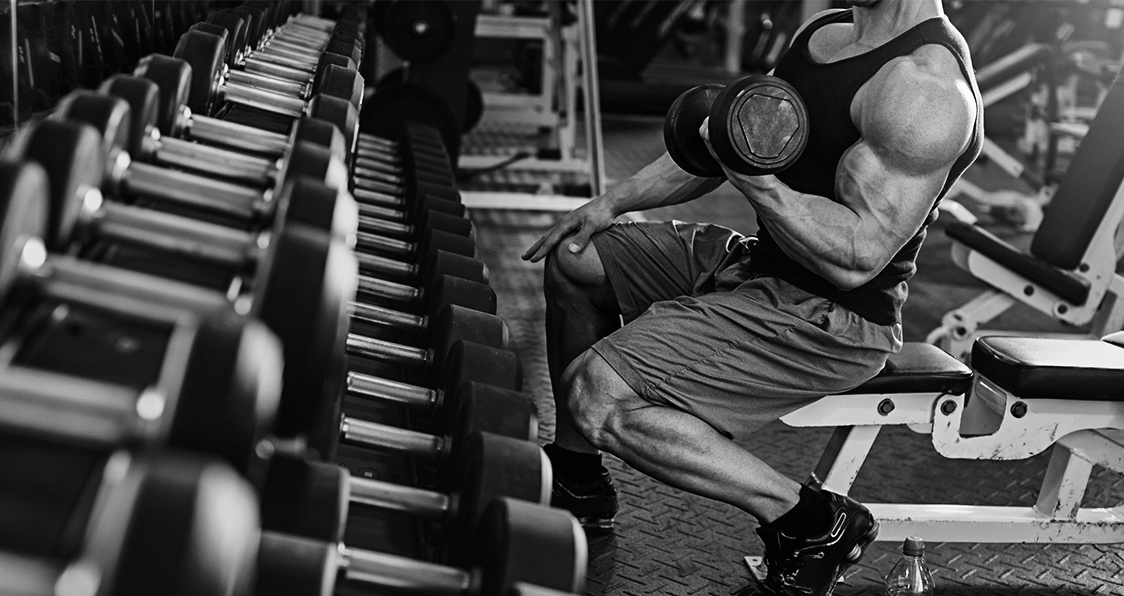
6 Forgotten But Incredibly-Effective Exercises Which Need To Be Brought Back
Reliving the Golden Days
The beautiful sport of bodybuilding has evolved with time. Machines, juices, and glamour have taken over the bodybuilding world. Don’t get us wrong, we are not complaining, and neither is this article meant to compare the current bodybuilders with the good old days. We’re here to talk about the six forgotten exercises that need to be brought back for bodybuilding’s sake.
With the emergence of the online fitness scene, we see a lot of “influencers” posting their workouts online. We can’t help but notice how different their workouts are from the typical old-school training routines.
It’s almost as if the workout vanity is as important as the physiques that are a result of it. Now, there is nothing wrong with that but we miss watching nasty bodybuilders grunting through their workouts in pain, sweat, and sometimes even blood.
We have put together a list of exercises that were a hit with the golden-age bodybuilders but have now faded with time. Make these exercises a part of your exercise arsenal if you love the golden-age aesthetics as much as we do.
6 Forgotten But Incredibly-Effective Exercises Which Need To Be Brought Back
Bench Tricep Dips
Imagine a sunny day in LA, and now picture yourself in a bare-bone gym in California surrounded by jacked dudes sporting staches, wearing tank tops and short shorts. Yep, we just narrated a scene out of the legendary documentary – Pumping Iron, and this is going to the theme of the article.
The triceps are an overlooked muscle. They don’t get the same love as their siblings – biceps. When people think “arm training” they usually picture themselves curling heavy dumbbells. Hardly anyone imagines themselves performing skullcrushers when arm training is brought up.
The bench tricep dips are on the verge of extinction and need to be rescued.
Steps:
Place your hands at a shoulder-width distance on a bench and lockout your elbows.
Your arms should be perpendicular to the floor at the top of the movement.
Extend your legs until your upper legs are parallel and your lower legs are perpendicular to the floor.
Place your feet flat on the floor.
Slowly lower your upper body until your chest reaches bench height.
Return to the starting position with an explosive movement and repeat for the recommended reps.
Modification: If you find this exercise too easy, you could add resistance by keeping your feet on an elevated platform or do what Arnold did – place a few weight plates on your lap and knock out the reps until the horseshoe muscles pop out at the back of your arms.
Barbell Wrist Curls
A few more years and you’ll only see people perform the barbell wrist curls in old bodybuilding videos or if a bodybuilding museum opens up someday. Forearms, these days, are considered nothing more than accessory muscles. People slap on a couple of fatgrips on their dumbbells or barbells and call it a day.
Steps:
Keep your forearms and elbows flat on a bench while holding a barbell with an underhand grip.
Curl the barbell using your wrists and pause at the top of the movement for a couple of seconds.
Return to the starting position and repeat for the desired reps.
Mod: While holding the barbell with an underhand grip targets the sides of the forearms, grabbing the bar with an overhand grip will work the top of your forearms. Don’t let your ego get the better of you while performing this exercise. Use weights you’ll be able to follow a full range of motion with.
Donkey Calf Raises
Back in the day, hitting the gym was about training with buddies. These days, machines and Instagram have consumed the roles of training partners. Most people like working out on machines in isolation.
We would recommend performing the donkey calf raises with people on your back as it adds a new dimension to your training – stability. Aesthetics are fine but you should also focus on training for functionality. Donkey calf raises ranks high on the list of forgotten exercises that need to be brought back.
Steps:
Place your toes on an elevated platform.
Bend over at your hips so that your upper body is taken out of the equation. It’s best to perform this exercise near a bench press or a smith machine as you’ll have something to hold on to.
Ask your training partner to hop onto your back while you perform the calf raises with a full ROM.
Hold and squeeze the life out of your calves at the top of the exercise.
Cross-Bench Dumbbell Pullovers
Dumbbell pullovers are one of the best exercises for building a V-tapered back, and yet only a few people consider adding them to their training routines. Performing the cross-bench dumbbell pullovers with a strict form will help open up your rib cage and add muscle mass to your lats.
Steps:
Lie down on a bench with your shoulder placed on the pads.
Grab a dumbbell with both your hands over your chest.
While keeping your elbows locked out, slowly lower the dumbbell until it is a few inches off the floor.
Return to the starting position and repeat for the recommended reps.
Keep your hips low to the ground and make sure you don’t lift them while you’re performing the exercise.
Arm Blaster Curls
The arm blaster curls have to be one of the most badass bicep exercises of all times. We still don’t understand how it lost its charm with time and ended up on a list of forgotten exercises. If your gym doesn’t have an arm blaster, add one to your gym bag, and your arms will thank you later.
Steps:
Adjust the arm blaster so it fits snugly under your chest.
Place the back of your elbows on the pads and grab a barbell while your arms are fully extended in front of you.
Curl the barbell by bending at your elbows with a strict form.
Only your lower arms should move while your upper arms stay in place.
Roman Chair Situps
How often do you see the current Mr. Olympias train abs on a Roman chair? Back in the day, a Roman chair was a staple in an ab training routine. The Roman chair situps can be much harder than normal crunches as it requires a lot more control from your stabilizers and a strong core.
Steps:
The Roman chairs usually have a lot of moving parts so you’d want to have the roller height and seat distance adjusted right.
Once you’re in position, place your hands on your chest or behind your head.
Slowly lower your torso backward until you’re at least parallel to the floor.
Return to the starting position with a slow and controlled motion.
Mod: You could make the exercise harder by adding resistance to the mix. Hold a dumbbell or a weight plate in front of your chest and perform the exercise to failure.
Do you use any of these forgotten exercises in your workout schedules? Let us know in the comments below. Also, be sure to follow Generation Iron on Facebook and Twitter.
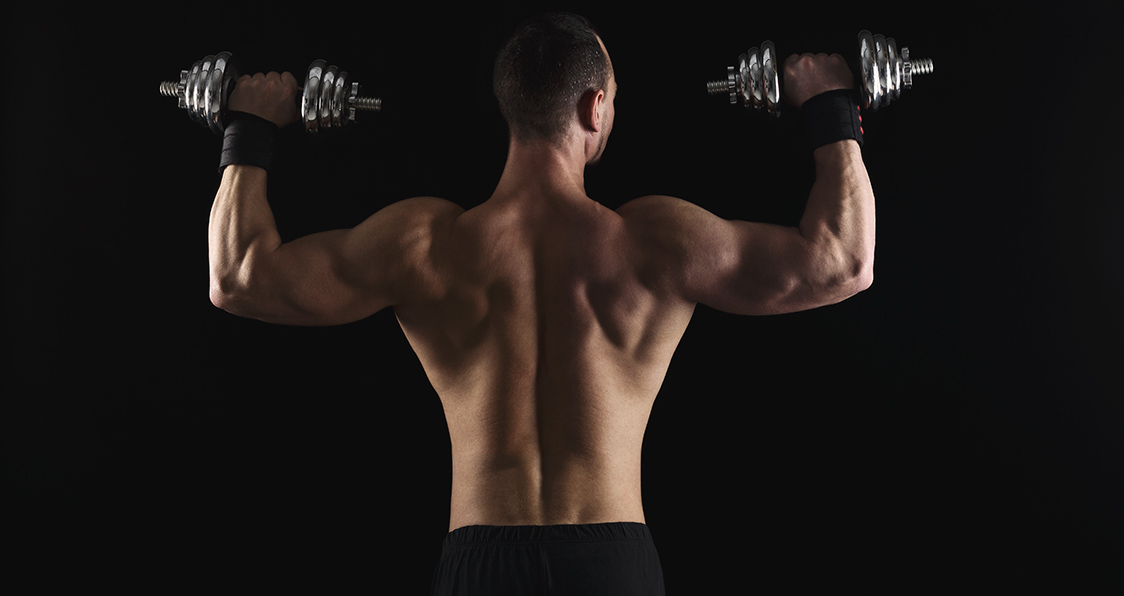
6 Best Exercises For Building Boulder Shoulders
Build Broad Shoulders With These 6 Exercises
“Broad shoulders don’t look nice,” said no one ever. Shoulders can be one of the hardest muscle groups to develop. Only a few people follow the right training routine to achieve big shoulders.
You need to follow a holistic approach in your training to achieve shoulders which look like massive boulders. Building round and big shoulder take much more than performing a few shoulder presses.
Arnold Presses
Arnold presses are one of the best shoulder exercises for overall shoulder development. Named after the Governator himself, the exercises can help in building round shoulder caps which look like the top of football helmets.
Sit on a chair while holding a dumbbell in each hand with a supinated (palm facing inwards) grip. At the beginning of the movement, hold the dumbbells at your shoulder level while keeping your elbows bent.
Rotate your arms as you lift the dumbbell over your head. Your palms should be facing forward at the top of the movement. Rotate your palms to the starting position as you lower the dumbbells.
Dumbbell Front Raises
The dumbbell front raises primarily work the anterior deltoids. The exercise helps in developing the separation between the chest and shoulders. Don’t make the mistake of using momentum by swinging back and forth to lift the dumbbell while performing the front raises.
Hold a dumbbell in each hand at your sides extended at arms length. Your palms should be facing your thighs at the starting position. Elevate your right arm while maintaining a slight bend in your elbow until it’s parallel to the floor. Return to the starting position and repeat with your left arm. Alternate between arms for the recommended reps.
Leaning Cable Side Lateral Raises
Using cables in your workout helps isolate your muscles which can build definition and conditioning. Side lateral raises work the medial delts. Stand beside the cable pulley machine so that your right arm is next to the pulley machine.
Hold the D-bar attached to the low pulley with your left arm. Lean toward your left side and elevate your left arm until it is parallel to the floor. Return to the starting position and repeat for the recommended reps. Repeat on your right side.
Seated Smith Machine Presses
Using a smith machine gets you the best of the isolation and compound movement worlds. Smith machine presses work the medial deltoids while keeping constant tension on your shoulders.
Place a chair under the smith machine bar so that anterior delts are directly under the barbell throughout the movement. Maintain a full range of motion to get the best results while performing all the exercise mentioned in the article.
Chest Supported Dumbbell Rear Delt Raises
Rear deltoids are one of the weakest muscle groups for most people. Since your rear delts are a stubborn muscle group, performing the exercise on an incline bench adds an isolation aspect to better target the muscles.
Adjust the incline bench so that it is forming a 60-degree angle with the floor. Grab a dumbbell in each hand with a supinated (palms facing inwards) grip extended at arms length. Elevate the dumbbells to your sides while maintaining a slight bend in your elbows until they are parallel to the floor. Repeat for the recommended reps.
Barbell Shrugs
Barbell shrugs work your trapezius muscles. Traps are a major muscle group which covers most of the upper back and the posterior of the neck. Shrugs are one of the easiest exercises to perform and yet many people do them wrong.
Hold the barbell with a shoulder-wide pronated (palms facing inward) grip. While maintaining a slight bend in your elbows, lift your shoulder as high as you can without using jerking. Hold at the top of the movement for a couple of seconds before returning to the starting position.
Which is your favorite shoulder exercise? Let us know in the comments below. Also, be sure to follow Generation Iron on Facebook and Twitter.
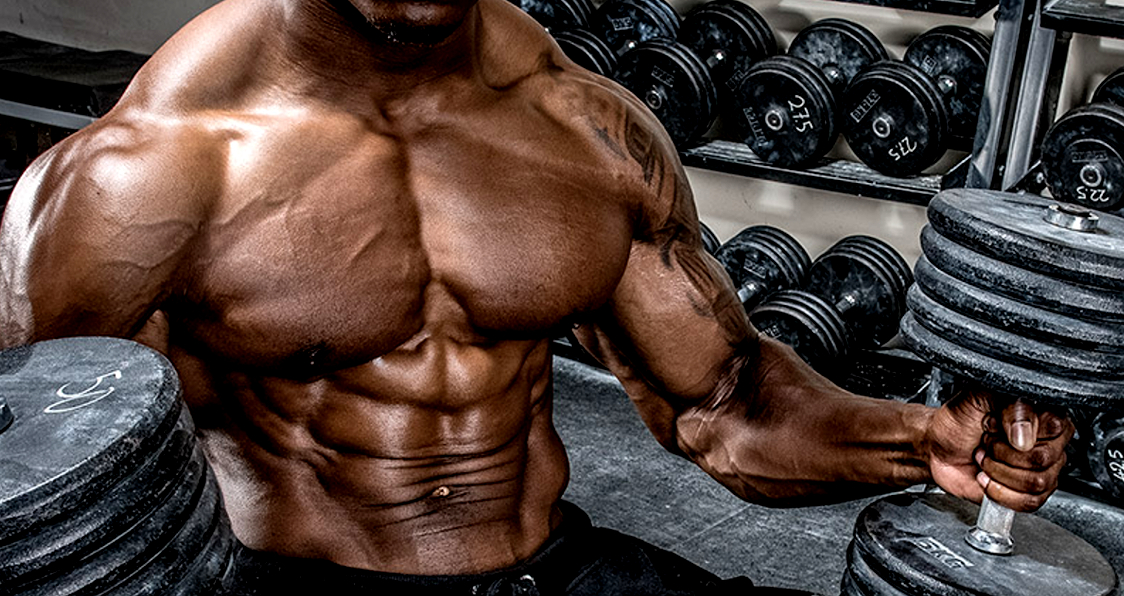
4 Tips On How To Handle ‘Two-A-Days’ To Maximize Your Gains
Two a-days are a practice reserved for those with luxuries of time and strength of spirit.
In this age of increasing amateur fitness, more and more gym-goers are finding excuses to fit workouts in over 7 times a week. Here are some tips to help manage the grueling but rewarding practice of two- a days.
1. Recovery Is King
Of course this always applies, but extreme attention must be payed when doing two a-days. If one is not getting enough sleep or calories, two workouts a day will start to become a detriment rather than a boost. Also, sitting at a desk for 8 hours in between workouts is a recipe for a stiff inhibited body- vulnerable to injury. Extra care must be taken both during off time, and during warm ups/ cool downs to make sure the body is supple and ready to work.
2. Diversify Workouts
Two a-days are not meant to be just an acceleration of an average workout program. Doing a program twice as fast as intended usually means you’re not working hard enough, or the program sucks. Two a-days are beneficial for the individual looking to attack the body in multiple ways.
Cardio workouts are excellent pairings on heavy bodybuilding days, can be done with a variety of machines, and can be anaerobic or aerobic in focus. As far as weightlifting, hitting the same movements multiple times a week can be beneficial, but the law of diminishing returns always looms large.
Make sure you have multiple ways to hit each body part, and that resistance types, set, and rep ranges are altered to constantly provide a new stimulus while allowing for recovery.
3. Have A Goal
Often, the biggest danger of doing two-a-days is becoming confused in routine- making up workouts on the way to the gym, altering workouts senselessly while at the gym, etc. It’s easy to be swept up in the feeling of ‘the grind,’ doing a ton of work without actually having a specific intention behind any of it.
Write down exactly what you want to accomplish and plan around that, or at least use it to orient yourself every day, so that the work, which often becomes monotonous, does not become mindless. Putting in twice the work and not seeing results because the work had no clear purpose can be a damaging psychological blow.
4. Make sure you have the drive.
From my own experience in sports training, often doing two-a-days becomes half-assing two workouts instead of really pushing through one. When one knows that they will have to work out later in the day, it’s easy to take the first workout lightly. This is a nasty habit. Both workouts don’t need to be balls to the wall, but they need to be complete workouts. Don’t delude you’re doing twice the work if you’re really just taking twice the time every day.
How do you prepare for two-a-days?
Let us know in the comments below. Also, be sure to follow Generation Iron on Facebook, Twitter, and Instagram.
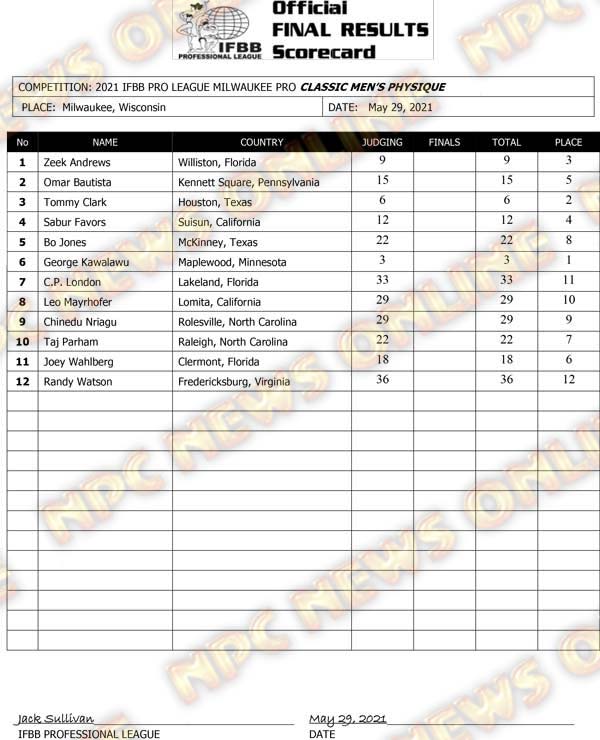
IFBB Milwaukee Pro 2021 Results
Full results for the IFBB Milwaukee Pro 2021.
This weekend held the IFBB Milwaukee Pro 2021 on Saturday, May 29th, 2021. The event took place in Milwaukee, Wisconsin. In the biggest highlight of the night, Pro bodybuilder George Kawalawu won the Classic Physique division. Read on for a full breakdown of the Milwaukee Pro 2021 results.
The Milwaukee Pro 2021 featured four divisions including Classic Physique, Men’s Physique, Bikini, and Wellness. While the first place victor does not receive automatic qualification for the Olympia, the top three earn points towards overall qualification.
The Milwaukee Pro 2021 is one event of many finally going underway after a delayed start to the IFBB Pro season due to the COVID-19 pandemic. With ristrictions lowering in nearly all states of the US, the 2021 season has now moved forward in full force. Though admittedly, both the Arnold Classic and the Mr. Olympia events have been delayed to later dates this year.
The full results have now been announced. Check out our full breakdown of the Milwaukee Pro 2021 results below.
Milwaukee Pro 2021: All Division Winners
A quick breakdown of the winners in each division from the Milwaukee Pro 2021. The top three placing winners earn points towards qualifying or the Olympia 2021 weekend.
Classic Physique: George Kawalawu
Men’s Physique: Rodrigue Chesnier
Bikini: Chenqi Liu
Wellness: Isabelle Nunes
2021 IFBB Milwaukee Pro Breakdown:
Classic Physique Results
First Place – George Kawalawu
Second Place – Tommy Clark
Third Place – Zeek Andrews
Fourth Place – Sabur Favors
Fifth Place – Omar Bautista
Men’s Physique Results
First Place – Rodrigue Chesnier
Second Place – Ismael Dominguez
Third Place – Daniel Stull
Fourth Place – Clarence McSpadden Jr.
Fifth Place – Mehdi Kabbadj
Bikini Results
First Place – Chenqi Liu
Second Place – Alessia Facchin
Third Place – Shelby Pierce
Fourth Place – Carolina Collazos
Fifth Place – Trisha Green
Wellness Results
First Place – Isabelle Nunes
Second Place – Sunny Andrews
Third Place – Renee Harshey
Fourth Place – Devyn Cambre
Fifth Place – Bruna Ferraz
Milwaukee Pro 2021 Scorecards:
Make sure to check out our full IFBB Pro results page from this year and previous years right here to catch up on any action you may have missed!
The GI Team is here to provide top news and original content for the new generation. The generation of bodybuilders who are pushing the sport to bigger and better places. Join The Movement. Become a part of Generation Iron!
IFBB California Pro 2021 Results
Who became champion at the IFBB California Pro 2021?
And just like that, in a flash, the pro bodybuilding season has kicked into full gear. This weekend held the IFBB California Pro 2021. It’s the third major IFBB Pro show to be held in May alone. Finally the sport of bodybuilding is starting to feel normal again. And with that – you can read on to get a breakdown of the California Pro 2021 results.
Two notable competitors going into this competition were Hassan Mostafa and Mohamed El Amem. Both of these competitors have already stepped on stage previously this month. Mostafa ended up placing 3rd at the New York Pro 2012. Mohamed competed in both the Indy Pro 2021 and the New York Pro. He placed 2nd at the Indy and 5th at the NY Pro. It’s clear these two competitors are hungry to earn a Mr. Olympia qualification.
But the clear highlight of the night was Patrick Moore. A pro competitor who has been hyped as “The Future” since he won the California Pro in 2019. Since then he has had a bumpy road placing 13th at the Arnold Classic and ultimately taking an extended offseason. He now claims to be ready for the stage again – and the California Pro 2021 was his target. Was he able to reclaim his glory from two years ago?
Compared to the New York Pro and Indy Pro – the California Pro was a relatively smaller affair. Not in terms of talent but in terms of divisions. The Cali Pro only featured the Men’s Open division. The winner of the division received qualification to the Mr. Olympia 2021 set to be held later in October.
The official IFBB California Pro 2020 results have finally arrived. You can check them out below.
IFBB California Pro 2021 Breakdown
Men’s Open Bodybuilding Results
First Place – Patrick Moore
Second Place – Coming Soon
Third Place – Coming Soon
Fourth Place – Coming Soon
Fifth Place – Coming Soon
Make sure to check out our full IFBB Pro results page from this year and previous years right here to catch up on any action you may have missed!
The GI Team is here to provide top news and original content for the new generation. The generation of bodybuilders who are pushing the sport to bigger and better places. Join The Movement. Become a part of Generation Iron!
